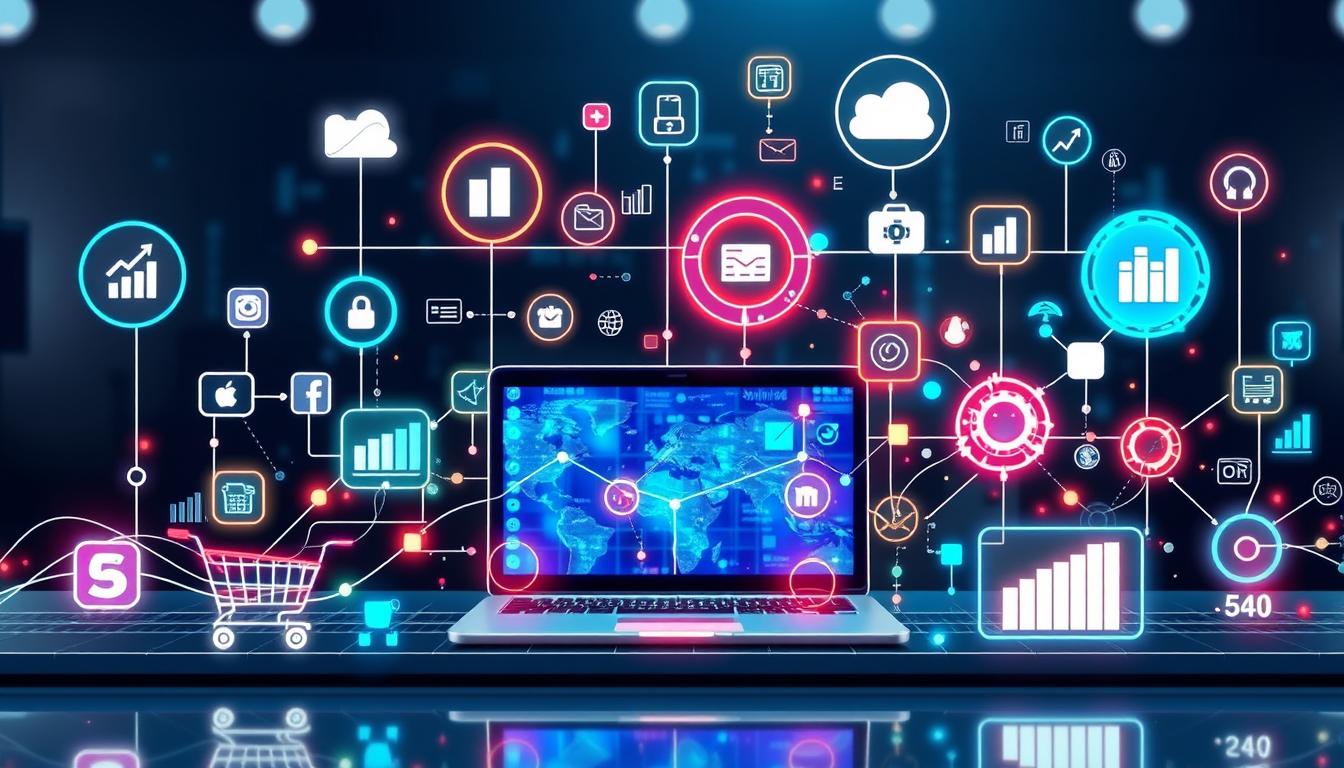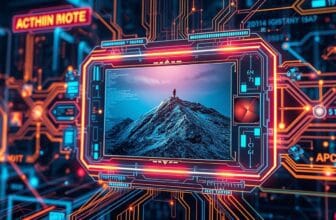Top 10 Technology Trends to Watch in 2024

Table of Contents
As we head into 2024, technology trends are moving fast. They’re changing many areas of life. For IT experts, the new tech will change how we work and live.
Keeping up with the latest tech is key for businesses. They need to use these new tools to stay ahead. This article will look at the top ten tech trends for 2024. They will shape industries and careers soon.
Key Takeaways
- AI technology is rapidly advancing, with its mainstream adoption expected to grow significantly in 20241.
- The expansion of 5G will lead to faster data speeds and more stable connections2.
- Augmented Reality (AR) is enhancing customer experiences in retail, leading to increased sales2.
- Blockchain is gaining traction beyond cryptocurrency, enhancing transparency and security2.
- Companies are employing new programming languages to adapt to emerging technologies1.
- Wearable Health Monitors provide continuous health insights, improving personal health management2.
- The Internet of Behaviors is reshaping user interaction through integrated AI technologies1.
Introduction to Emerging Technology Trends
Exploring emerging technology trends is crucial. A detailed look shows how big data helps process huge amounts of data. This boosts decision-making in many fields3. Artificial intelligence (AI) has also changed a lot, as AI systems can learn and predict from big data. This opens doors for automated solutions and better customer service4.
AI and natural language processing (NLP) are leading the way in improving customer service. They make chatbots more effective and sentiment analysis better3. The Internet of Things (IoT) is also changing things, connecting physical objects for better automation and analysis3. As I look into these trends, I see how technologies like machine learning (ML), augmented reality (AR), and virtual reality (VR) are changing how we interact with technology. They also bring new security and regulatory challenges for companies to handle5.
This fast-paced tech world means businesses need to keep up with these trends. By embracing digital change and working together, companies can stay ahead in the tech world4
AI-Generated Content Revolution
The use of AI in content creation has changed how businesses talk to their audience. Tools like GPT and DALL-E make it easier to create top-notch text, images, and videos. They meet specific market needs. In fact, 66% of companies worldwide are looking into GenAI, showing a big interest in using it to make content better6.
Applications of AI in Content Creation
AI has many uses in making content. It can take over tasks that humans used to do, like editing and reporting. AI can make summaries, change article titles, and check data, making content making faster and better. Tools like Grammarly help with editing, and AI checks facts to keep journalism honest. Big networks are starting to use AI to make news, showing they want to use AI to share information7.
Benefits of AI for Businesses
The business benefits of AI technology go beyond just making content. AI helps companies understand what customers want and make content that fits their needs. This is key for keeping customers interested. Research shows that giving great experiences is what sets companies apart today. So, focusing on making experiences better is important for growing online6.
As companies move to new models, investing in tech and people is crucial. Being real in content is also important for building trust. Since 50% of old code can be replaced by GenAI, it’s a chance for companies to update6.
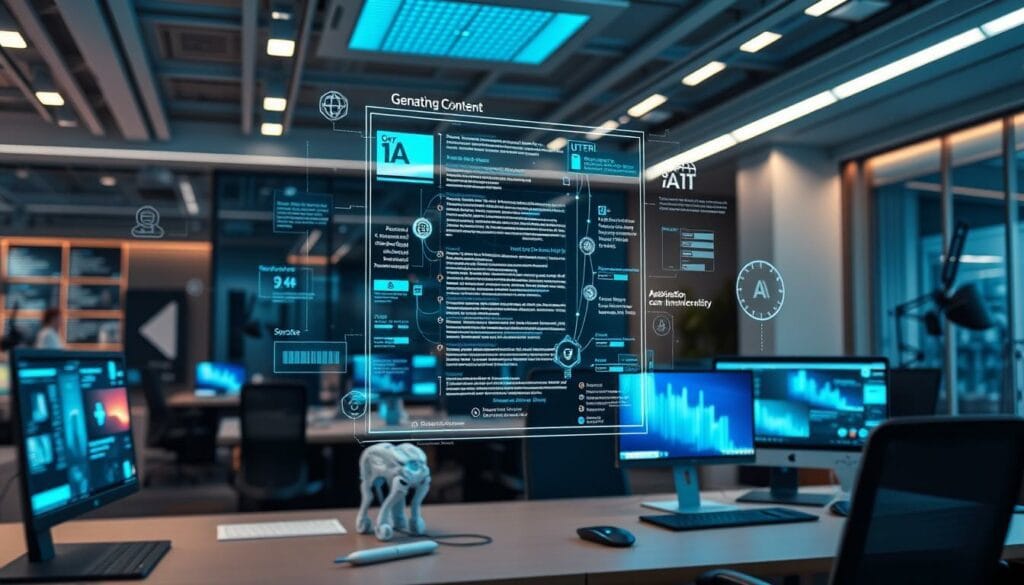
| Statistical Insight | Impact |
|---|---|
| AI automation in editing (9%) and reporting (15%) | Enhances productivity in journalism7 |
| 66% of organizations exploring GenAI | Growing interest in AI-driven content strategies6 |
| AI tools improve efficiency | Facilitates faster and higher-quality content generation7 |
| 50% of legacy application code replaceable by GenAI | Opportunity for technology upgrade6 |
Advancements in Quantum Computing
Quantum computing is changing how we solve complex problems. It uses quantum mechanics to process information in new ways. This technology has the power to change many industries.
Understanding Quantum Mechanics
Quantum mechanics studies tiny particles and their energy. Unlike regular systems, quantum systems can be in many states at once. This makes quantum computing tricky, but also very powerful.
Companies like IBM are leading the way. They’ve made quantum processors with hundreds of qubits. These advancements show how far quantum computing has come8.
Impact on Cryptography and Drug Discovery
Quantum computing affects important areas like cryptography and drug discovery. It could break current secure systems. Governments are planning how to keep data safe.
Companies are working on new, quantum-proof ways to encrypt data. They’re also improving quantum computing for drug research. This could lead to faster discoveries in the future9.
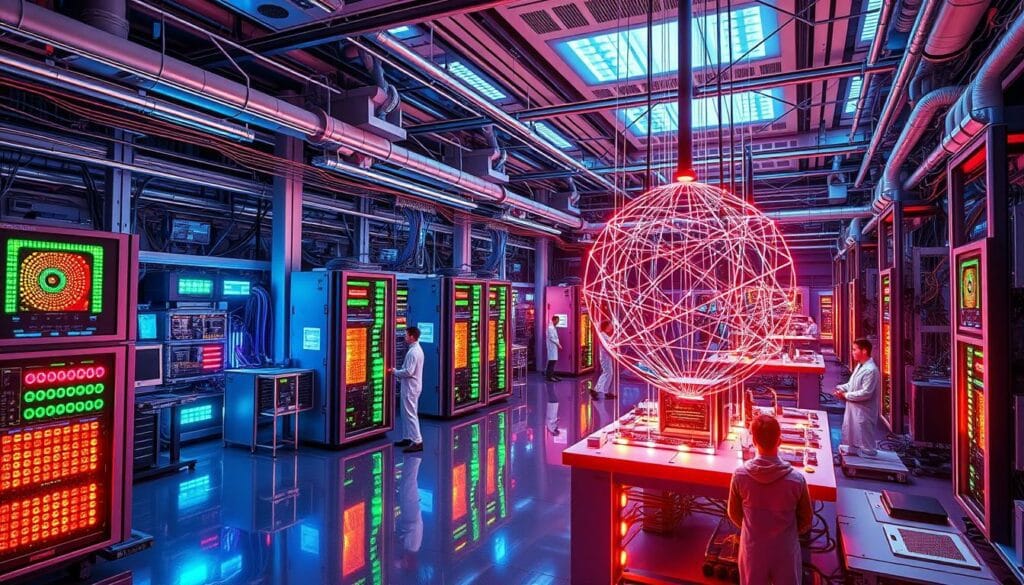
| Feature | Current State | Future Projections |
|---|---|---|
| Qubit Development | 433 Qubits (Osprey) | 1,121 Qubits (Condor) in 20239 |
| Impact on Cryptography | Risks to standard algorithms10 | New encryption standards anticipated |
| Drug Discovery | Increased efficiency in simulations | Utilization expected in upcoming years |
5G Expansion and Its Implications
The growth of 5G technology is changing how we talk and connect. It brings faster speeds and lower delays. This helps many areas grow quickly.
Enhancements in Real-Time Communication
In 2023, 62% of smartphones have 5G11. This boosts mobile talks and lets people get info fast. Over 200 million homes and businesses in North America already use 5G11.
This wide use of 5G changes tech a lot. It makes data sharing in real-time possible. This is key for many industries to work better.
Transformative Technologies Fueled by 5G
5G needs to be very fast, with up to 1-millisecond delay and 10Gbps data rate12. By 2029, 5G will be in 5.6 billion subscriptions, making up 60% of all mobile users12.
This growth will help new tech like AI in smart cities. It can make cities better by managing traffic and air quality11. 5G in healthcare is also exciting. It will make surgeries and patient data access easier11.
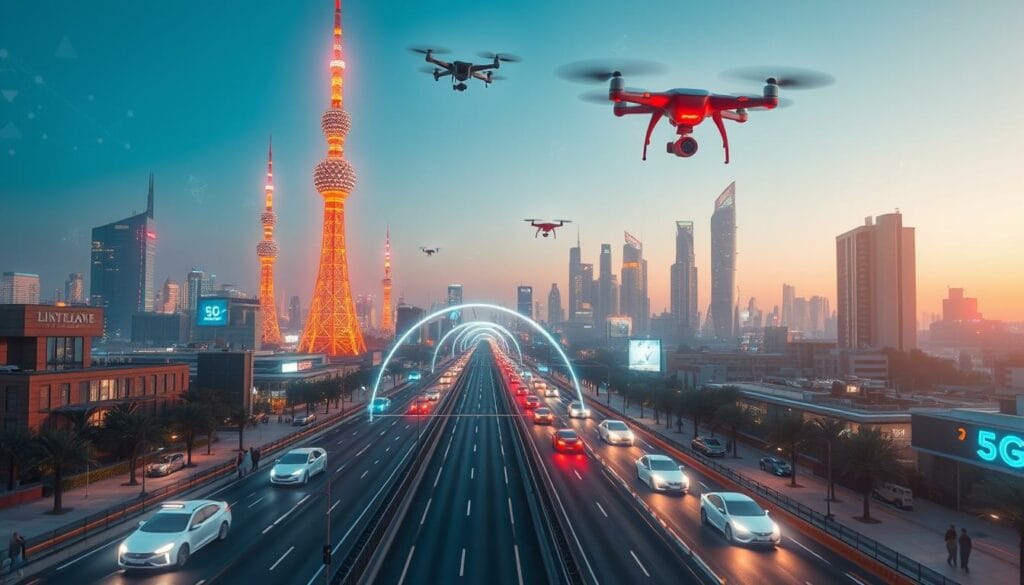
Virtual Reality 2.0: The New Era of Immersion
The world of virtual reality is changing fast, bringing new experiences to life. The VR market was worth USD 1.4 billion in 2020 and is expected to hit USD 25.8 billion by 2027. This is a growth rate of 43.3% each year13. This growth shows how much people are interested in VR, from gaming to learning.
Companies like Oculus and HTC Vive are leading the way in VR. They keep making things better for users. Now, VR is used in more ways than just games.
VR has improved a lot, with better pictures and tracking. People feel more connected in VR worlds13. It’s also good for our brains, helping with focus and memory13.
VR is also used in therapy for anxiety. Many people feel less scared after VR sessions13. This shows VR’s power in helping people.
Looking ahead, there’s a big VR competition starting in 2025 with a $1 million prize14. It will show how VR can change sports. There’s also tech that tracks health through nerves, showing VR’s role in health14.
VR is even helping with meditation, making it easier to focus on breathing14. These changes show VR’s goal to make virtual worlds feel real. It’s changing how we play, learn, and heal.

Augmented Reality in Retail: Enhancing Customer Experience
Augmented reality (AR) is changing augmented reality retail by making shopping better. More and more retail brands are using AR. They offer new ways to see products before buying them.
AR makes shopping more fun and engaging. It helps customers feel more connected to the products they buy.
Use Cases of AR Technology
Many companies are using AR in their stores. For example, Heinz uses AR on its packaging to show recipes. Wayfair has a 3D room app that lets you see furniture in your home15.
Sephora Virtual Artist lets you try makeup virtually. GAP has a virtual dressing room app. It lets you see clothes on a 3D figure15.
Impact on Consumer Behavior
AR changes how people shop. It makes them more interested in what they buy. For example, Brazil’s C&A uses AR hangers to show social media likes on clothes15.
AR helps online stores manage what customers expect. It also lowers return rates. This leads to more sales and better service16.
Companies like IKEA say their AR app makes online shopping more certain. This leads to happier customers and fewer returns17.
The future of shopping will include more AR. It will change how we interact with brands. Personalization and better customer experiences will be key in retail.

Internet of Things (IoT) in Smart Cities
The Internet of Things (IoT) is key in making cities smarter. It helps cities innovate and manage technology better. For example, New York is working on connected vehicles to reduce accidents18. Los Angeles uses cameras and sensors to improve traffic flow18.
The IoT market in Smart Cities is growing fast, with billions of dollars in revenue expected19. By 2025, there will be 75.44 billion IoT devices, showing the need for better infrastructure19. People are very happy with Smart Cities, with a satisfaction rate of 98%19.
In London, the SmartPark project helps find parking spots, making driving easier18. Copenhagen uses smart grids to lower carbon emissions from heating18. New York’s MyNYCHA app makes it easier for residents to track repairs18.
By 2050, cities will be home to 66% of the world’s population, making smart city projects even more important19. London, Paris, and Hong Kong are leading the way with their IoT projects19. These efforts aim to make cities safer and services better, improving life for everyone19.
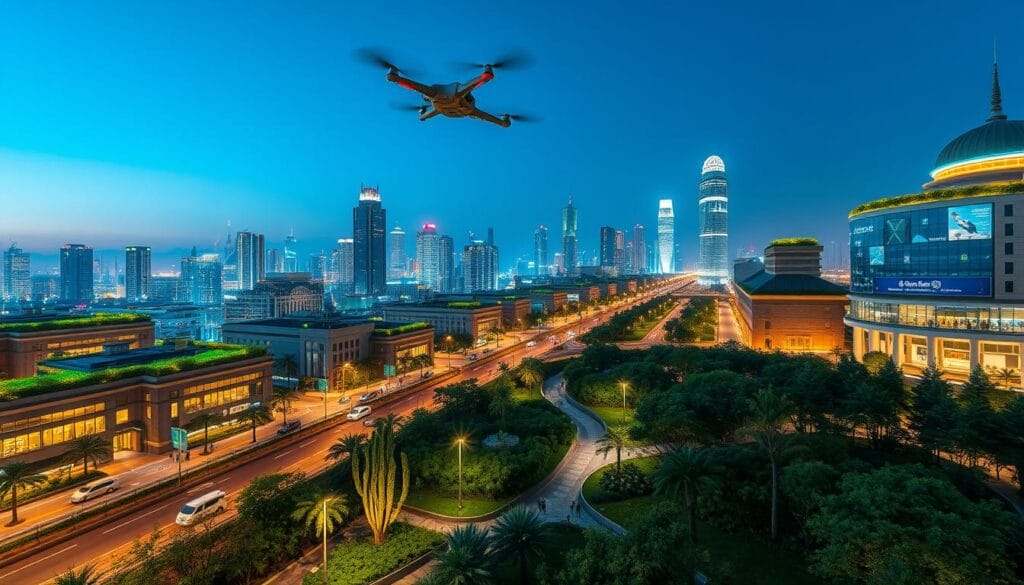
Breakthroughs in Biotechnology for Agriculture
Biotechnology is changing how we grow crops, thanks to CRISPR technology. CRISPR lets us edit genes with precision. This means we can grow crops that fight off pests and handle tough weather better.
In 2012, most corn, cotton, and soybeans in the U.S. were genetically engineered. This shows how important these crops are for food security, especially with climate change.
Role of CRISPR in Crop Development
CRISPR is making crops more resilient to climate change. Farmers in the U.S. are using these new technologies. Three federal agencies check if these products are safe.
The U.S. Environmental Protection Agency has 390 biopesticide active ingredients. These are key in modern farming.
Adapting to Climate Change Through Technology
Biotechnology is key in fighting climate change in farming. In Missouri and Kansas, using crop waste for biofuels could help the environment and economy.
Also, biotechnology can turn farm waste into biodegradable materials. This helps the planet and boosts local jobs.
Rise of Autonomous Vehicles and AI
Autonomous vehicles have come a long way since the late 1700s. Companies like Tesla and Waymo are leading the way in self-driving cars. They use sensors like LiDAR, radar, and cameras to understand their surroundings and make decisions on the fly20.
Artificial intelligence (AI) is key to these advancements. Machine learning algorithms get better with time, helping vehicles navigate and make decisions. This makes transportation safer and more efficient20. V2X communication also plays a big role, improving how vehicles interact with their environment.
Autonomous systems are changing industries like agriculture and entertainment. They promise to make roads safer by reducing accidents. Self-driving cars could also make traffic flow better and reduce congestion20.
Lawmakers are starting to catch up with these changes. The US passed the SELF DRIVE Act in 2017 to guide the use of autonomous vehicles. Countries like China, Germany, and the UK are also setting rules for testing these technologies safely21.
The rise of autonomous vehicles is changing transportation forever. It will impact cities and industries in big ways. It could lead to new jobs and change how we live and travel2021.
Blockchain Technology Beyond Cryptocurrency
Exploring blockchain technology, I find it has many uses beyond just cryptocurrency. Its key features are transparency and security. These make it perfect for blockchain applications in many fields. It’s especially useful where trust and accurate data are crucial.
Transparency and Security Benefits
In finance, banks spend a lot on Know Your Customer (KYC) projects. They use blockchain for its secure data handling. This helps fight fraud and cuts costs22.
Smart contracts help companies make quick payments for valid claims. This boosts efficiency and builds trust among all parties23.
Applications in Supply Chain Management
Blockchain is also key in supply chain management. It’s vital for tracking goods. For instance, Walmart uses it to track produce from farm to store.
This improves visibility and helps spot contamination quickly. It builds trust2223. Companies in many sectors use blockchain to streamline logistics and build open relationships with customers.
Healthcare also benefits, using blockchain for safe patient record sharing and managing drug supplies23.
Edge Computing: Processing Data at the Source
Edge computing is becoming key in industries, cutting down on latency and bandwidth use. It works by processing data near its source, making operations more efficient. Only 27% of companies have really used edge computing, but 54% find it interesting24.
The importance of IoT edge computing is growing. Soon, 75% of data will come from outside big data centers24. Edge computing makes data processing faster by doing it locally. This is crucial for things like self-driving cars and smart factories25.
Edge computing is not just fast; it also saves money and energy. It keeps data safe by processing it locally25. For example, in retail, it can mix video and sales data to understand what customers want24.
| Aspect | Centralized Computing | Edge Computing |
|---|---|---|
| Data Processing Location | Central data centers | Near data source |
| Latency | Higher (long-distance transfer) | Lower (local processing) |
| Bandwidth Use | Higher | Lower |
| Security | Data transmitted to central servers | Local processing enhances security |
| Energy Efficiency | Higher emissions from long data transfers | Reduced emissions due to local processing |
In short, edge computing is changing how businesses work. It helps handle big amounts of data quickly. This is key for making fast decisions in today’s fast-paced world2425.
Personalized Medicine: Tailoring Health Solutions
Personalized medicine is changing how we care for patients. It uses lots of data to create health plans just for each person. Doctors who use this method see costs drop by 5% to 10% and patients are happier26.
They also see fewer hospital stays and readmissions. Predictive models help spot disease risks early. This means doctors can act fast to help26.
Artificial intelligence and machine learning are making treatments better. They use genetic data to improve therapy results. This leads to better health outcomes for patients26.
Wearable tech lets doctors keep an eye on patients all the time. This means treatment plans can change quickly. They adjust based on what the patient’s body is doing26.
Countries like Italy and the UK are making personalized medicine a big part of their health plans. This shows a big change towards this new way of treating patients27.
Healthcare data is growing fast, at 48% a year. This makes it easier to tailor treatments and prevention plans. But, we must also think about ethics. We need strong rules to keep patients safe and ensure everyone benefits from these advances26 and27.
Neuromorphic Computing: Mimicking the Human Brain
Neuromorphic computing tries to copy the brain’s neural structures. This makes computers work better in many ways. Intel’s Hala Point is a big step in this direction. It runs AI tasks 50 times faster than old computers and uses 100 times less power28.
Hala Point uses 1,152 Loihi 2 processors. These have 1.15 billion artificial neurons and 128 billion artificial synapses28. This shows how far we’ve come in making computers like the brain.
Neuromorphic systems are very good at saving energy. They do 15 trillion operations per watt for AI tasks. This is way better than regular computers28.
The human brain only uses 20 watts of power. This makes neuromorphic tech great for devices that need to save energy, like edge computing devices29. These systems can handle complex tasks and make decisions fast29.
Neuromorphic systems can keep working even if some neurons fail. This is important for important tasks29. Scientists and engineers from different fields are working together to improve neuromorphic computing29. They aim to make these systems better for real-world AI uses.
Green Energy Technologies: Innovations for Sustainability
The growth in green energy innovations is key to today’s energy scene. These advancements are making energy both efficient and affordable, especially with renewable energy like solar and wind. In 2023, solar photovoltaic (PV) led the way, adding most of the new renewable energy globally30.
By 2028, solar and wind power are set to nearly double, reaching 710 GW. This shows a steady increase in these clean energy sources30.
Modern solar tech has improved a lot. Today’s PV cells can catch more sunlight, even on cloudy days. They also store extra energy for when the sun isn’t out, making solar power more reliable31.
Wind power has also made big strides, especially with offshore farms. These farms use the stronger winds at sea to make more electricity. This cuts down our need for fossil fuels. Plus, small hydropower systems are becoming popular in rural areas for their clean energy and low environmental impact31.
New ideas are popping up everywhere. For example, biofuels made from used cooking oil and farm waste could replace fossil fuels. These changes help lower greenhouse gas emissions, which is good for our planet30.
| Technology | Advancements | Benefits |
|---|---|---|
| Solar PV | Capture broader spectrum; Efficient in cloudy conditions | Enhanced practicality; Cost-effective |
| Wind Power | Offshore installations; Stronger wind harnessing | Higher electricity generation; Reduced fossil fuel reliance |
| Biofuels | Derived from waste sources; Variety of feedstocks | Renewable; Carbon-neutral potential |
As we move forward with sustainability technology advancements, focusing on better energy storage is key. Clean hydrogen is becoming crucial for reducing emissions in transport and industry. This shows a big change in how we use energy for the future32.
Conclusion
Looking at the future technology trends, we see a big change. This change is about mixing new solutions in many fields. AI, quantum computing, and green tech are leading the way. They show us a future where tech insights in 2024 will change our lives and work.
Solar energy is a great example. It has the power to change how we use energy. With 173,000 terawatts of power from the sun, we see big chances for green energy3334.
It’s important for everyone to keep up with these trends. Knowing about AI in making content, 5G for better communication, and self-driving cars helps us use tech well. These tips guide us in making smart choices for the future.
Being ready to accept these new things helps us grow. As we get closer to 2024, I’m looking forward to seeing how these changes will make our world better. They will help us use technology to improve our lives and protect our planet.
FAQ
What are the top technology trends to watch in 2024?
Top trends include artificial intelligence, quantum computing, and 5G. Also, biotechnology and the Internet of Things (IoT) are key. These will change many industries and jobs.
How is AI transforming content creation?
AI is changing content creation with tools like GPT and DALL-E. It makes high-quality text, images, and videos. This helps businesses make better marketing and save money.
What impact does quantum computing have on cybersecurity?
Quantum computing can break current encryption but also offers new security solutions. It’s a big challenge and opportunity for digital security.
What does 5G technology mean for businesses?
5G means faster internet for IoT, augmented reality, and real-time data. It makes businesses more efficient and opens new ways to connect.
How are virtual reality and augmented reality being used across industries?
Virtual reality is used in healthcare, education, and training for immersive experiences. Augmented reality improves shopping and reduces returns in retail.
What role does IoT play in smart city development?
IoT is key for smart cities. It connects devices to analyze data for better living and resource use, like traffic and safety.
How is biotechnology addressing global food security?
Biotechnology uses CRISPR to make crops more resilient. This is crucial for higher yields and fighting climate change.
What are the future benefits of autonomous vehicles?
Autonomous vehicles use AI for safer and more efficient travel. They will change public transit and logistics, reducing accidents and pollution.
What advantages does blockchain offer beyond cryptocurrency?
Blockchain adds security and transparency to supply chains. It reduces fraud and ensures data traceability, making it a game-changer.
How does edge computing improve data processing?
Edge computing processes data closer to its source. This cuts down on latency and bandwidth, crucial for IoT’s real-time needs.
What is personalized medicine and how is it being advanced?
Personalized medicine uses genetic and lifestyle data for tailored healthcare. Biotechnology innovations, especially in oncology, are leading to better treatments.
What is neuromorphic computing?
Neuromorphic computing mimics the brain for better pattern recognition. It could redefine AI and robotics, enabling more complex learning.
How are green energy technologies evolving?
Green energy is getting more efficient and affordable, especially in solar and wind. Advances in energy storage are key for global sustainability.
Source Links
- https://www.transcenda.com/insights/technology-trends-to-watch
- https://www.simplilearn.com/top-technology-trends-and-jobs-article
- https://aloa.co/blog/what-are-emerging-technologies
- https://connect.comptia.org/blog/emerging-trends-in-information-technology
- https://www.pwc.com/us/en/tech-effect/emerging-tech/essential-eight-technologies.html
- https://blogs.idc.com/2024/04/15/the-rise-of-ai-generated-content-in-the-experience-orchestrated-business-era/
- https://www.louisbouchard.ai/ai-and-journalism/
- https://www.forbes.com/sites/tiriasresearch/2023/11/28/quantum-computing-is-coming-faster-than-you-think/
- https://www.technologyreview.com/2023/01/06/1066317/whats-next-for-quantum-computing/
- https://link.springer.com/article/10.1007/s13222-024-00467-4
- https://www.ibm.com/think/insights/5g-future
- https://www.thalesgroup.com/en/markets/digital-identity-and-security/mobile/inspired/5G
- https://quantumzeitgeist.com/virtual-reality-2-0-immersive-experiences/
- https://www.ronimmink.com/how-will-vr-2-0-impact-on-your-future-business-model/
- https://surveysparrow.com/blog/augmented-reality-customer-experience/
- https://www.startek.com/insight-post/blog/how-augmented-reality-enhances-the-retail-customer-experience/
- https://medium.com/@briancjensen1/the-role-of-augmented-reality-in-enhancing-customer-experience-4abb786fd38e
- https://www.rishabhsoft.com/blog/iot-in-smart-cities-applications-benefits
- https://caburntelecom.com/role-iot-smart-cities/
- https://siliconvalley.center/blog/the-rise-of-autonomous-systems-self-driving-cars-and-drones
- https://dig.watch/trends/rise-autonomous-vehicles
- https://appinventiv.com/blog/blockchain-beyond-cryptocurrencies/
- https://www.tdk.com/en/tech-mag/past-present-future-tech/impact-of-blockchain-technology-on-business
- https://www.techtarget.com/searchdatacenter/definition/edge-computing
- https://blog.seeburger.com/what-is-edge-computing-and-why-is-edge-computing-important-for-processing-real-time-data/
- https://www.tresastronautas.com/en/blog/the-impact-of-technology-on-personalized-care-for-patients
- https://www.ncbi.nlm.nih.gov/pmc/articles/PMC10058568/
- https://www.livescience.com/technology/computing/intel-unveils-largest-ever-ai-neuromorphic-computer-that-mimics-the-human-brain
- https://www.linkedin.com/pulse/neuromorphic-computing-mimicking-human-brain-ai-applications-hqxzc
- https://knowhow.distrelec.com/energy-and-power/top-10-innovative-technologies-in-sustainable-energy-sector/
- https://sustainablereview.com/top-10-green-technology-innovations/
- https://www.eib.org/en/essays/green-energy-innovation
- https://pressbooks.pub/anne1/chapter/conclusion/
- https://opentextbooks.clemson.edu/sciencetechnologyandsociety/chapter/conclusion/


